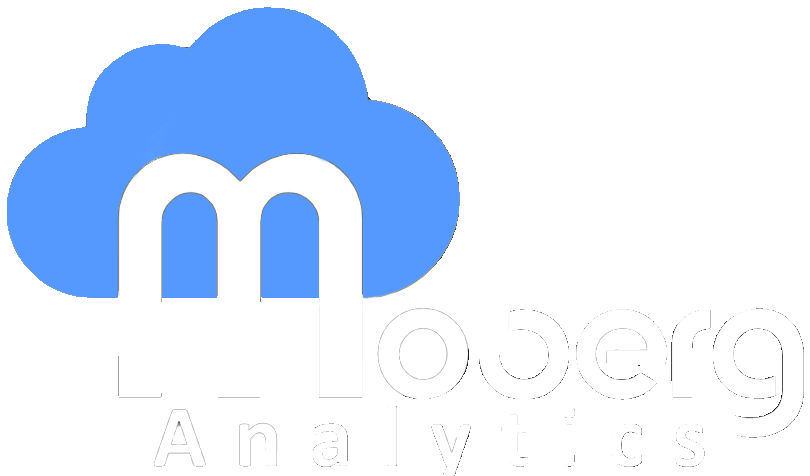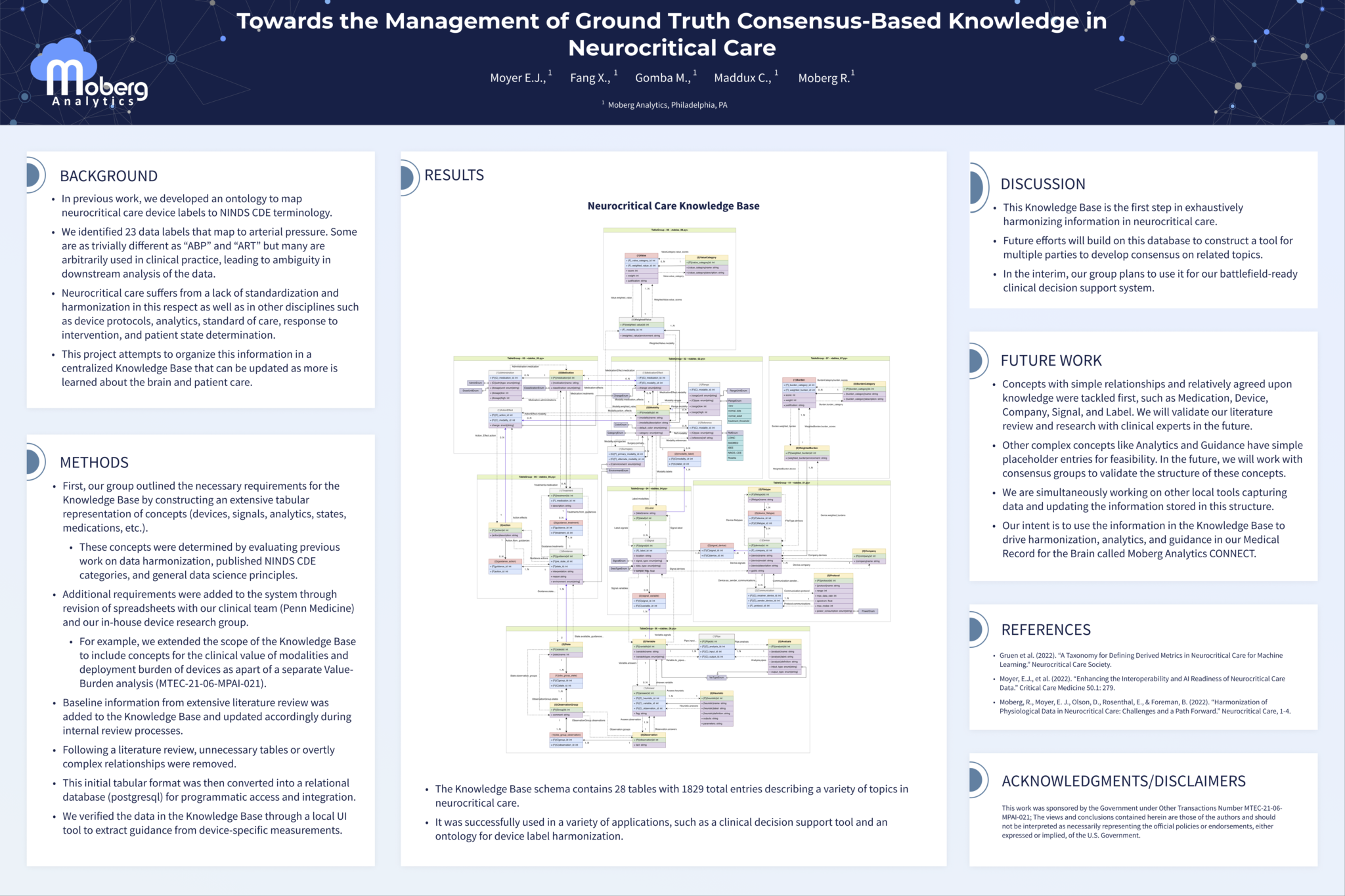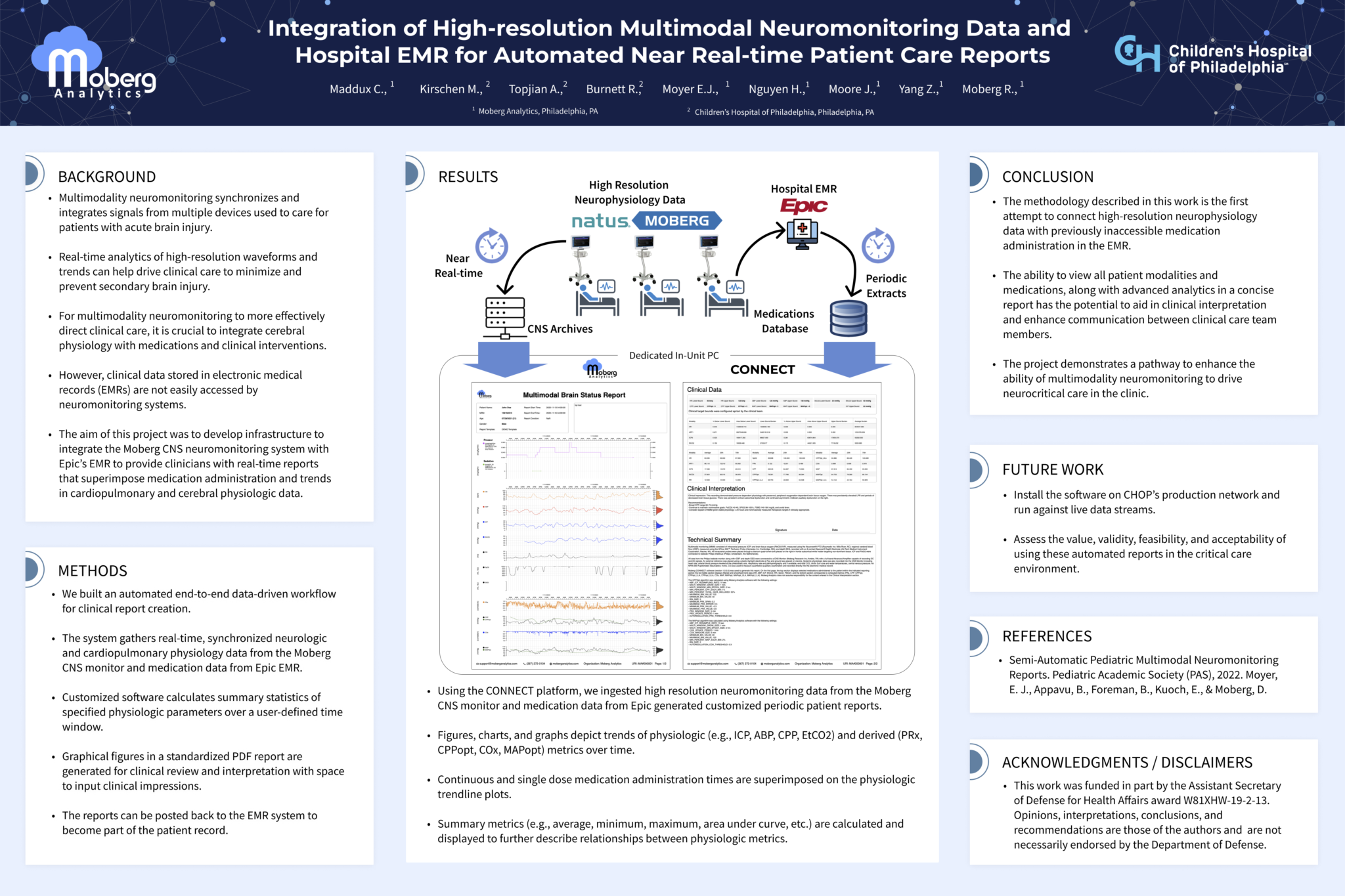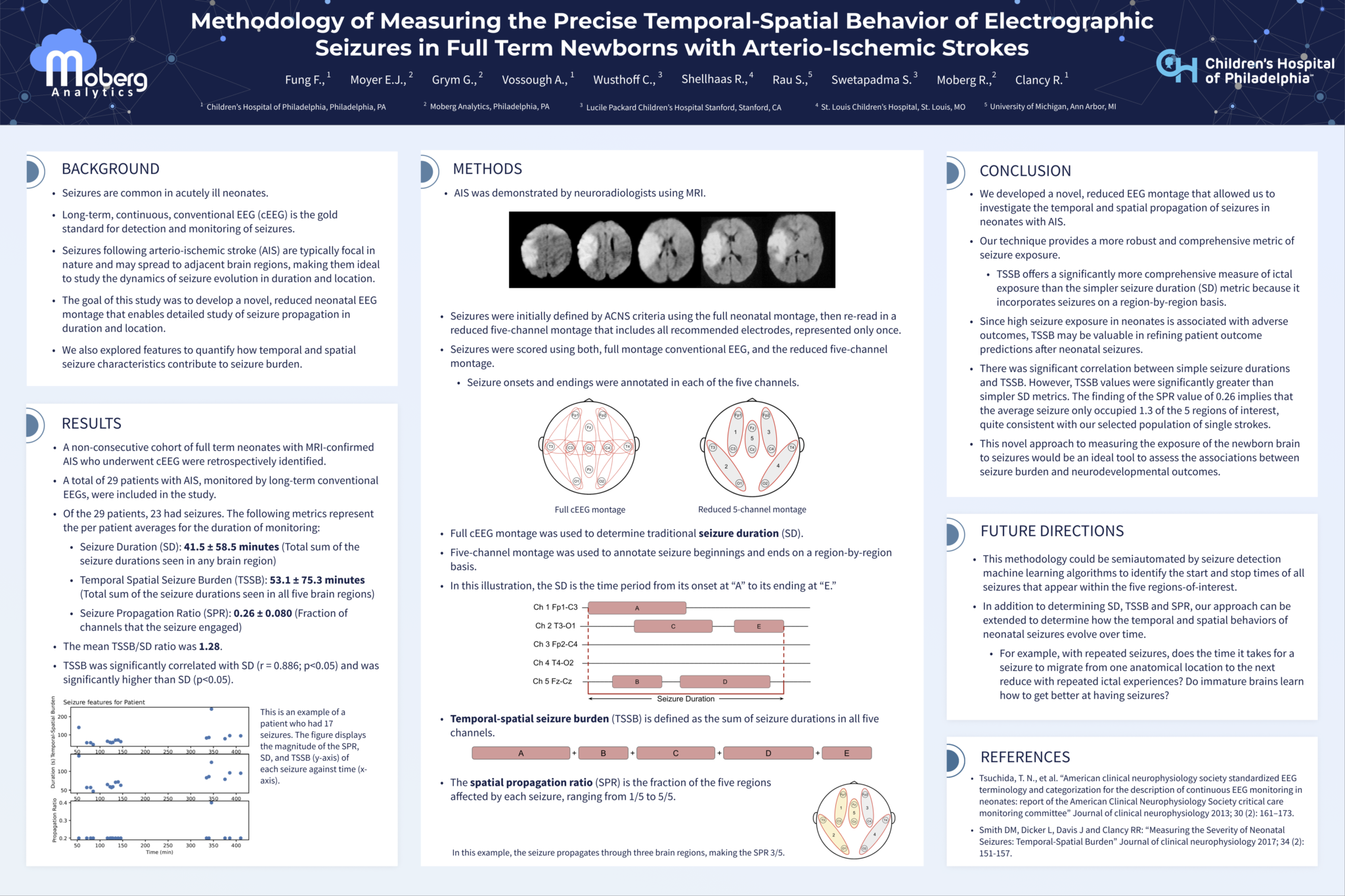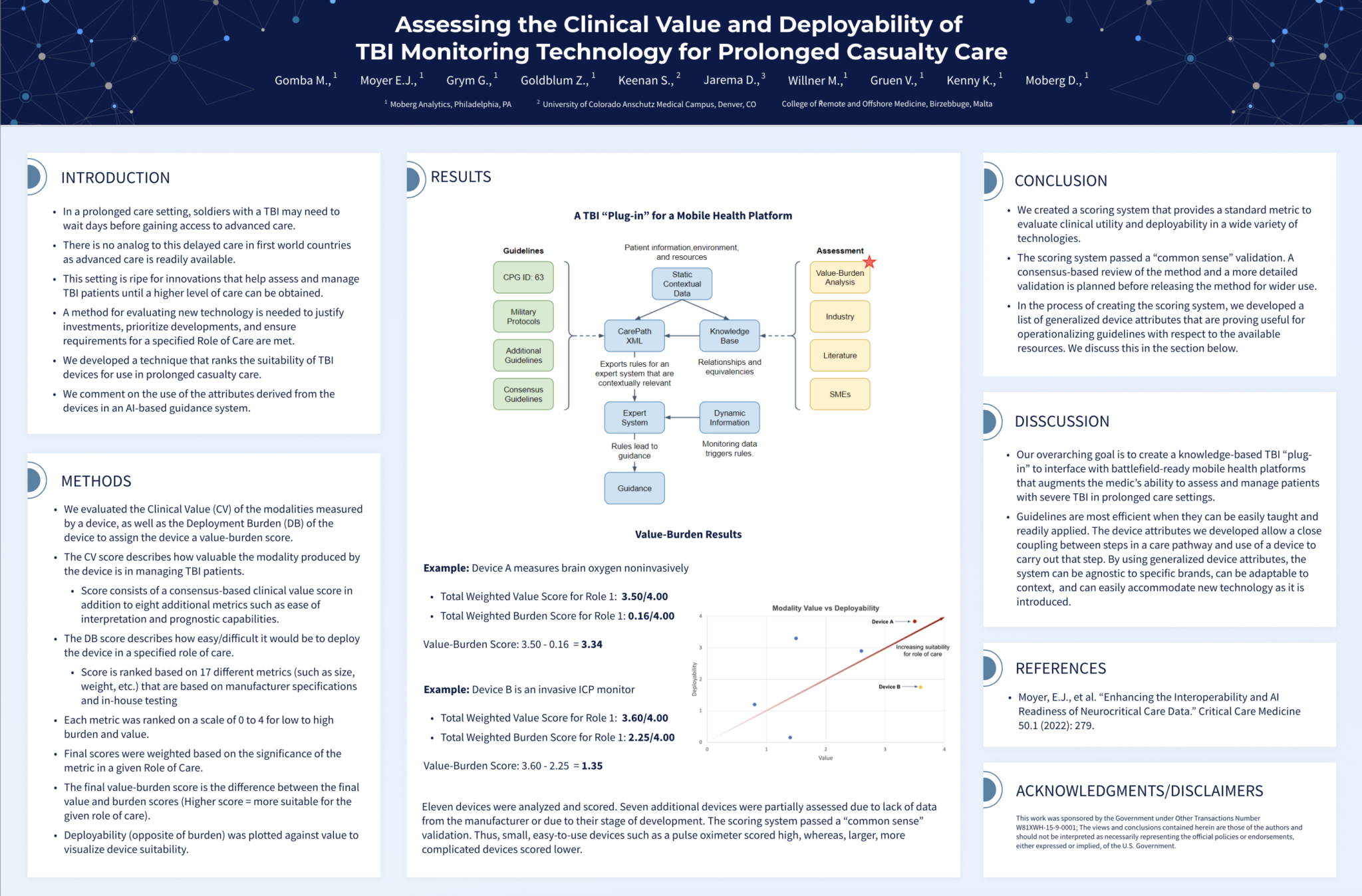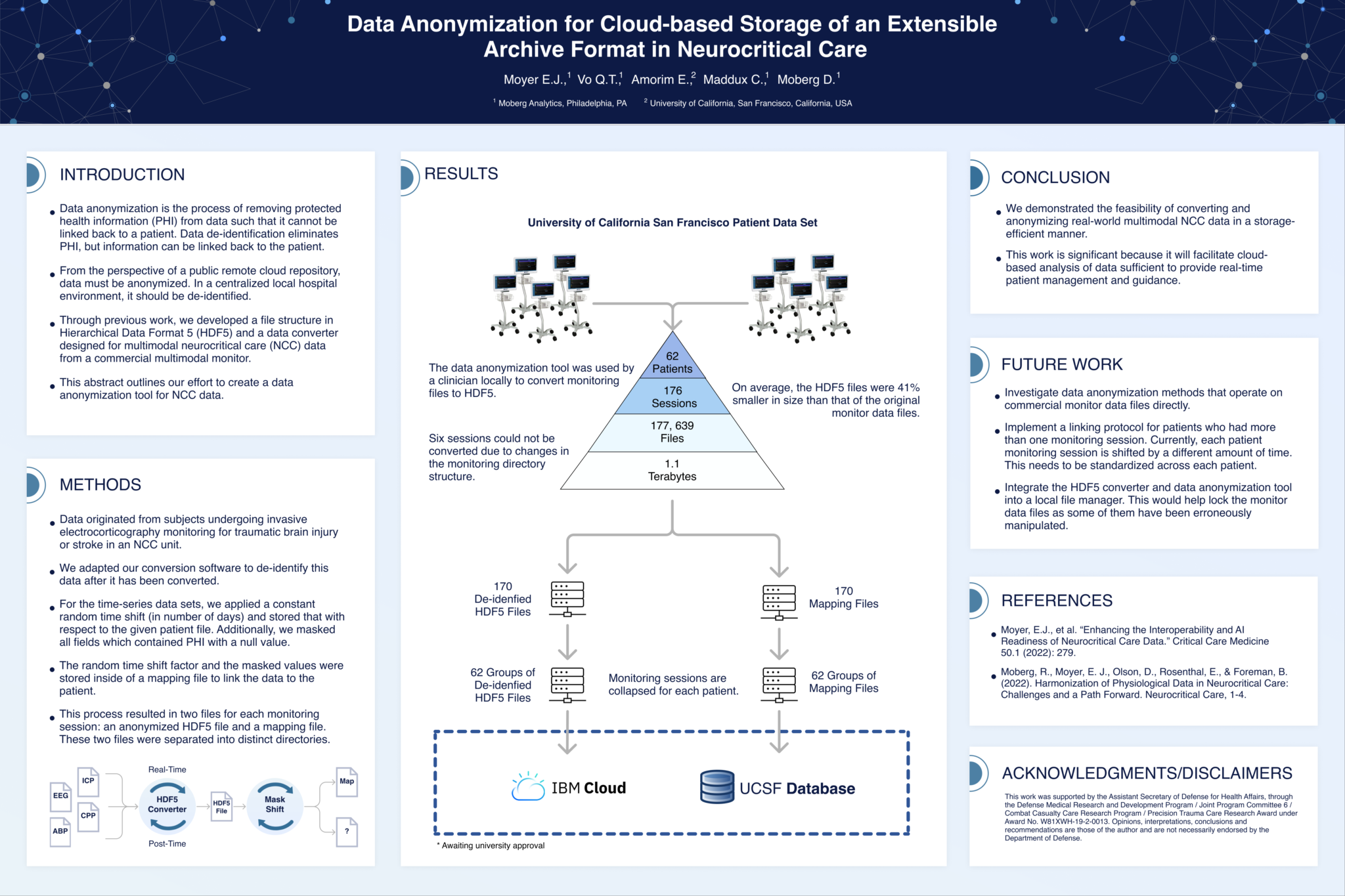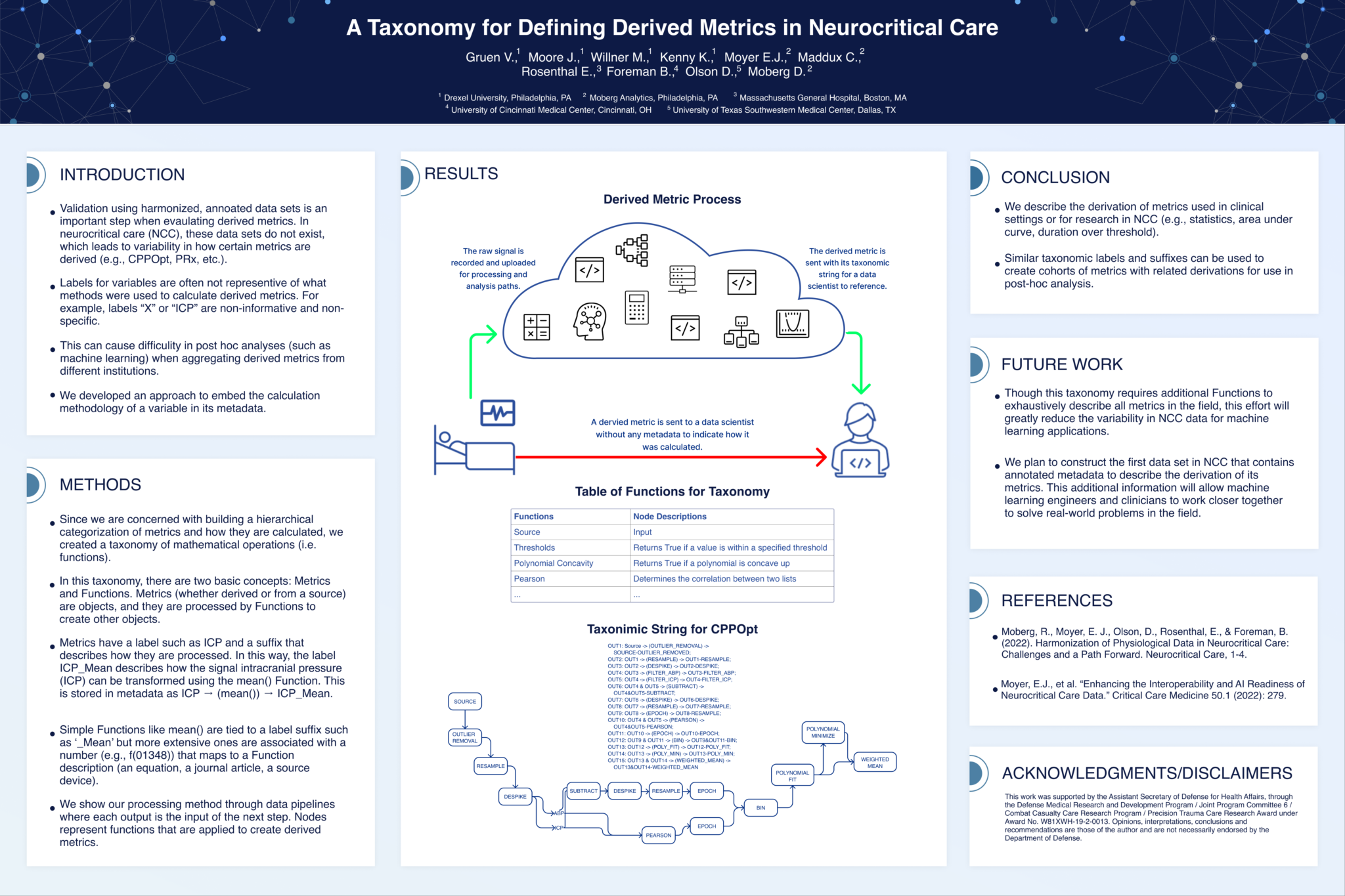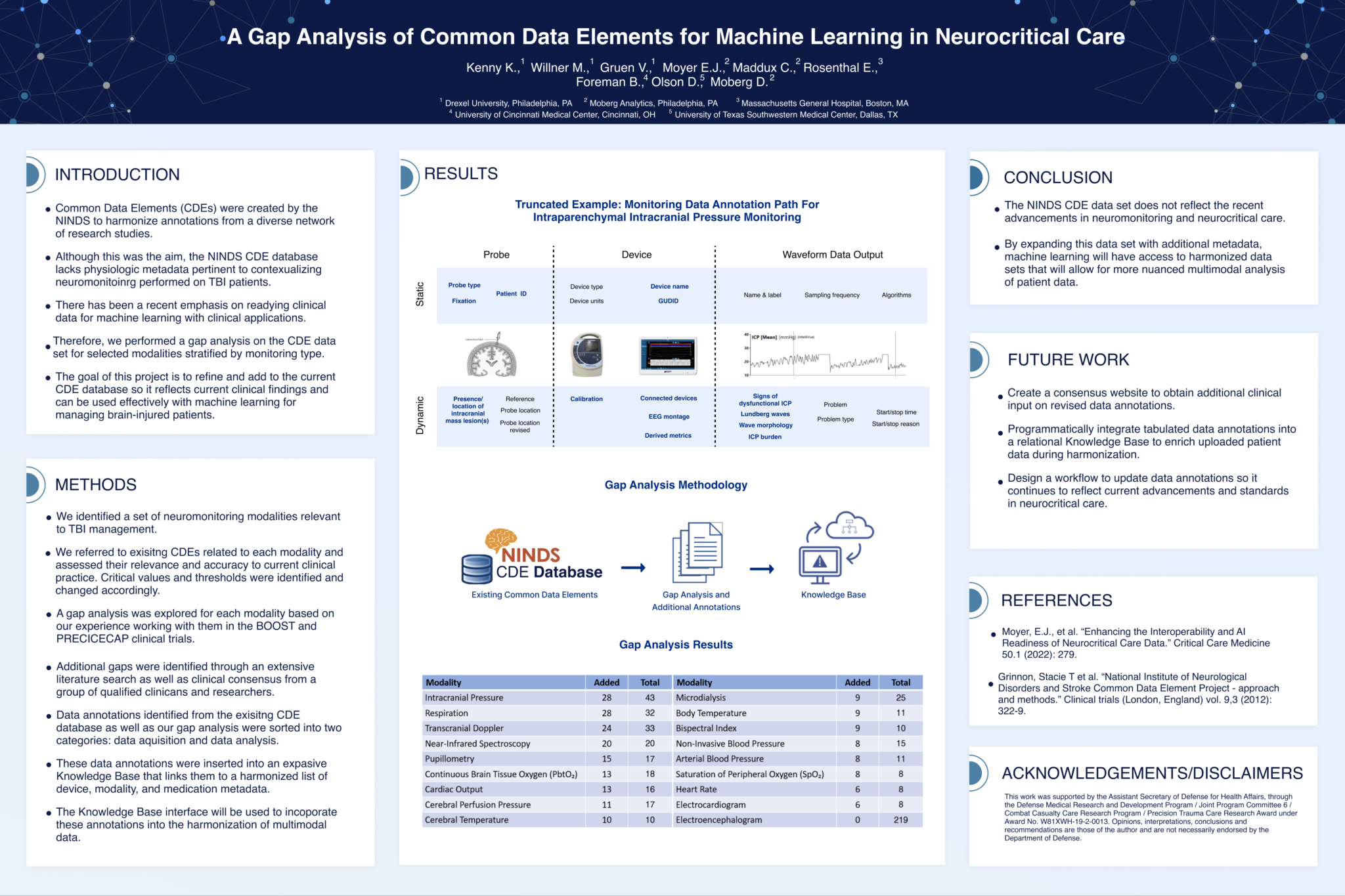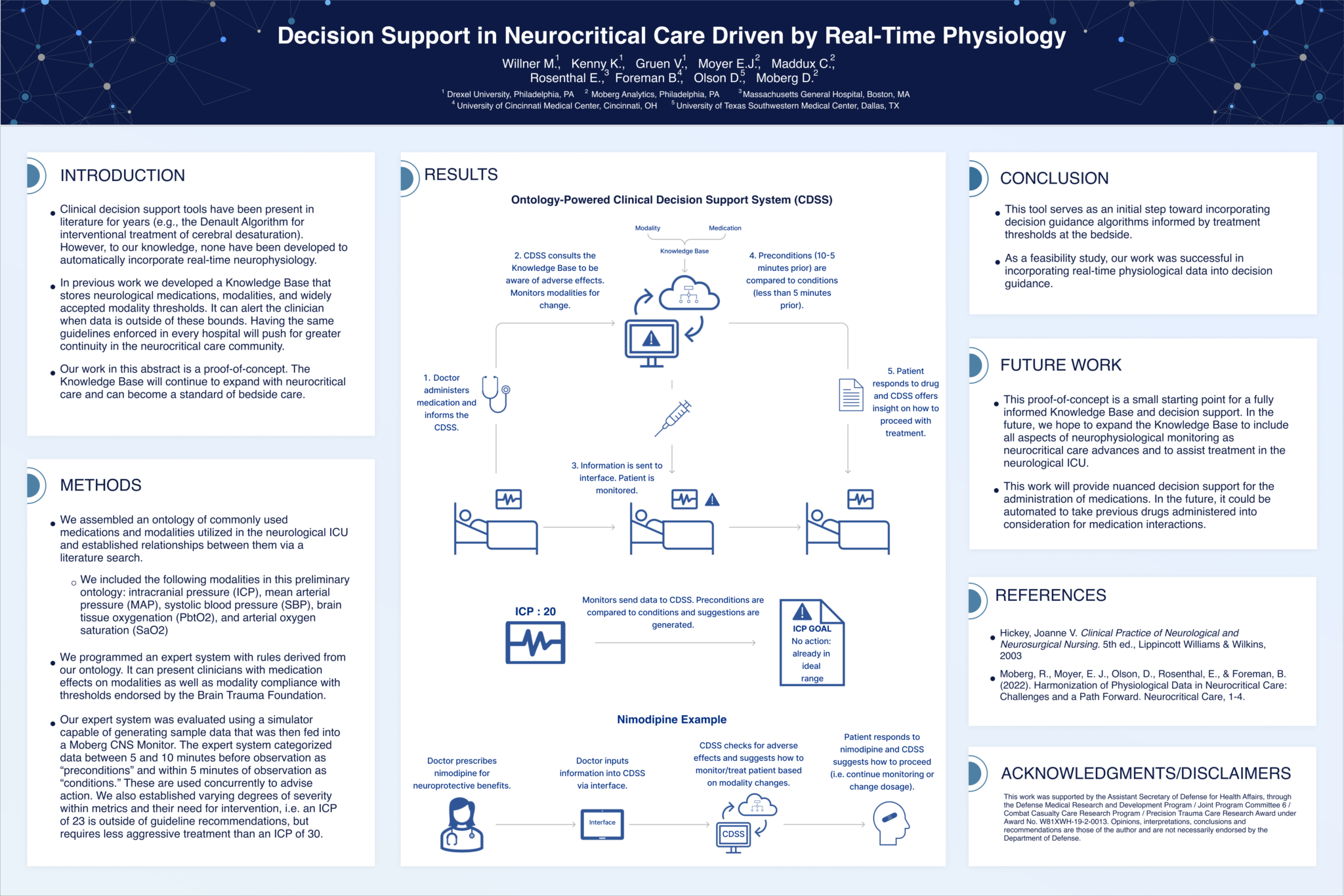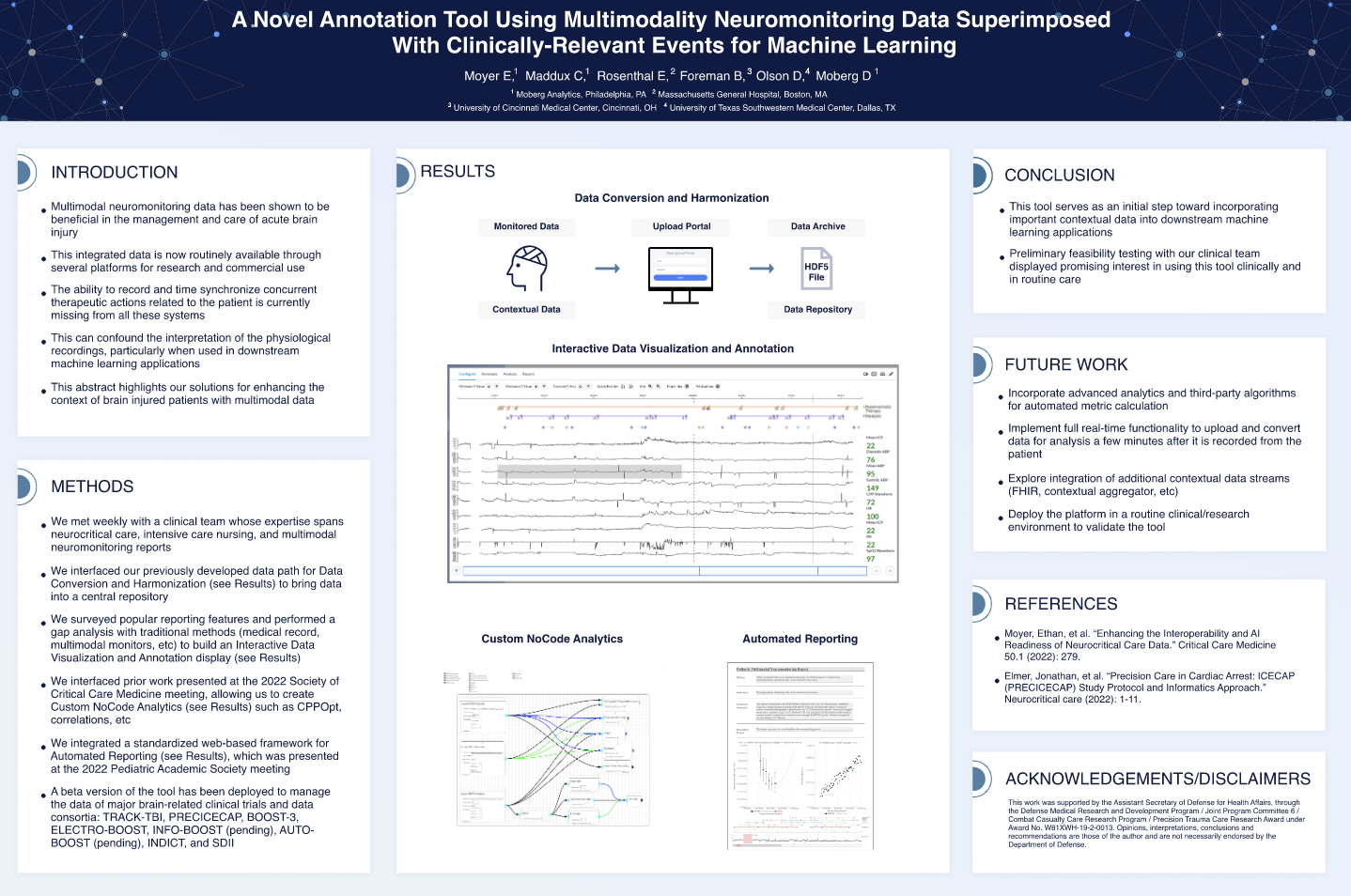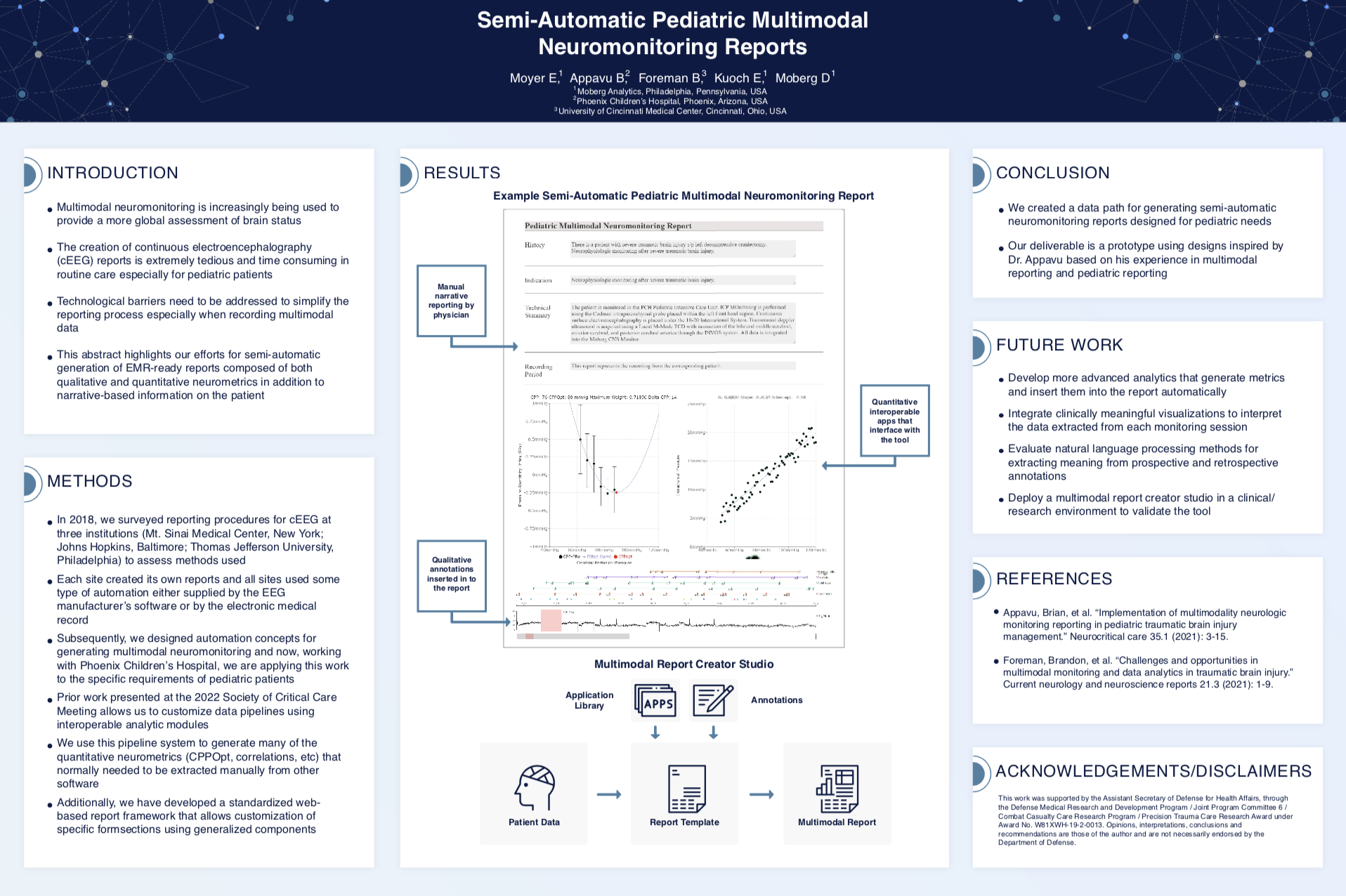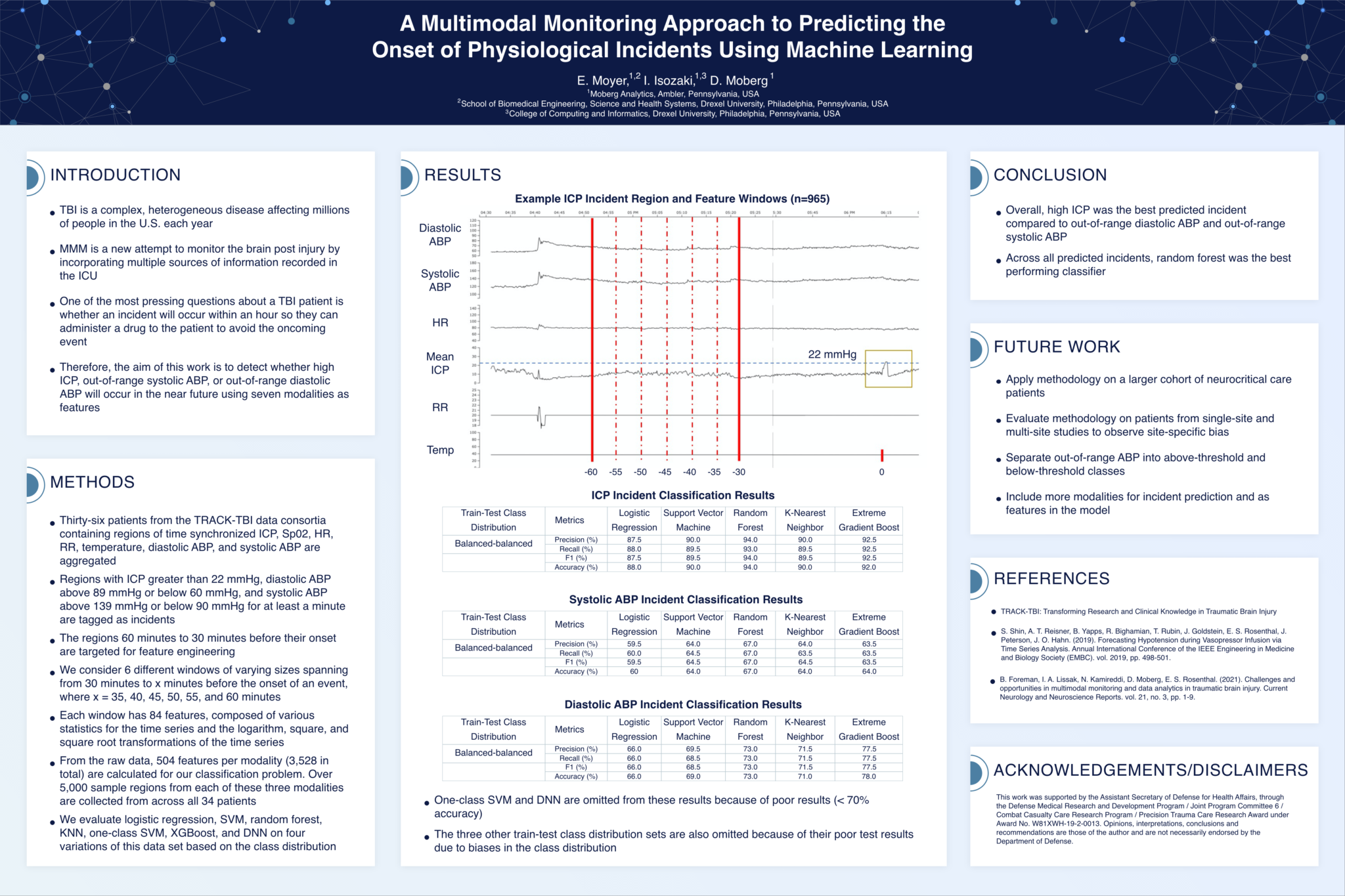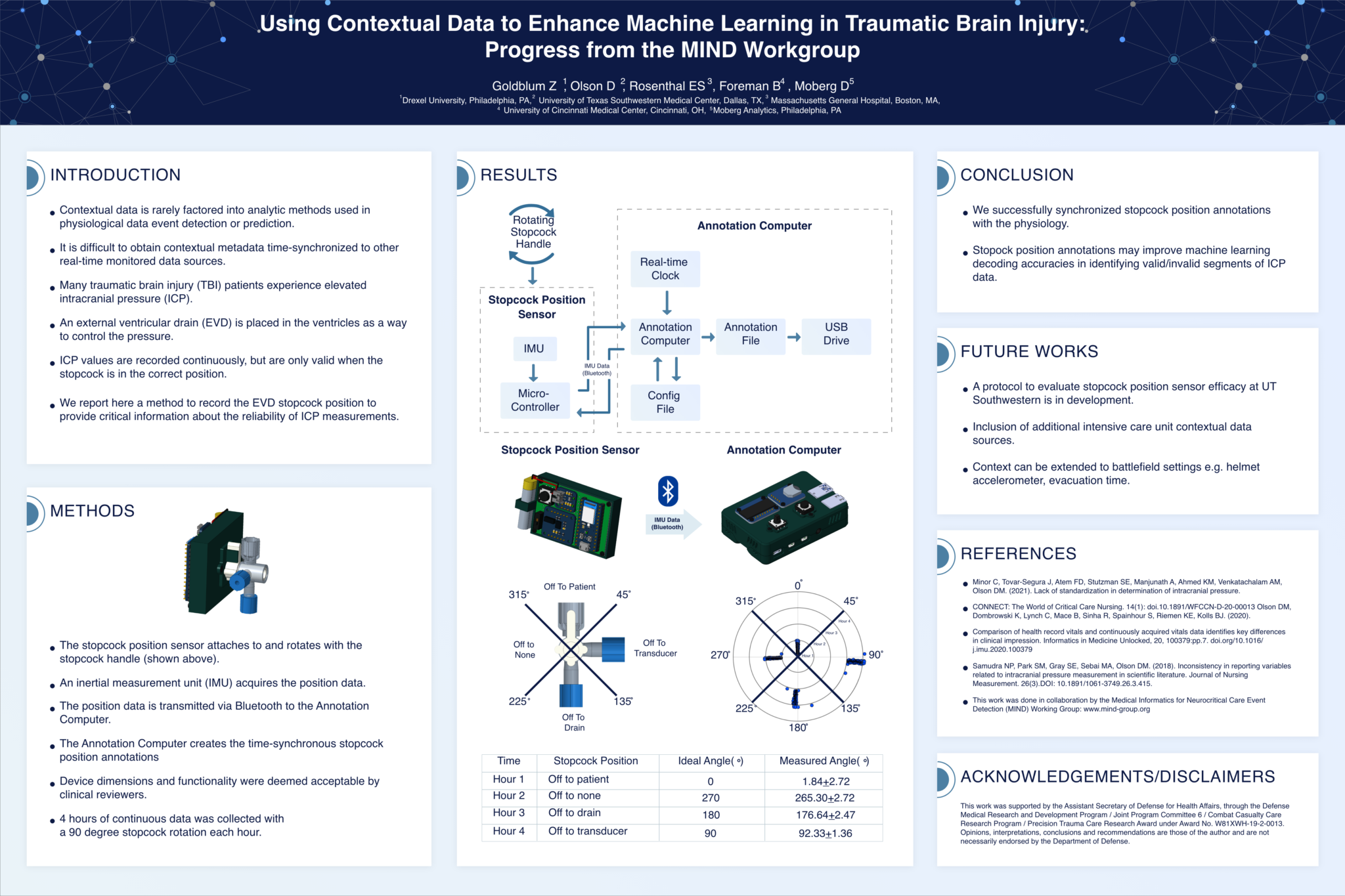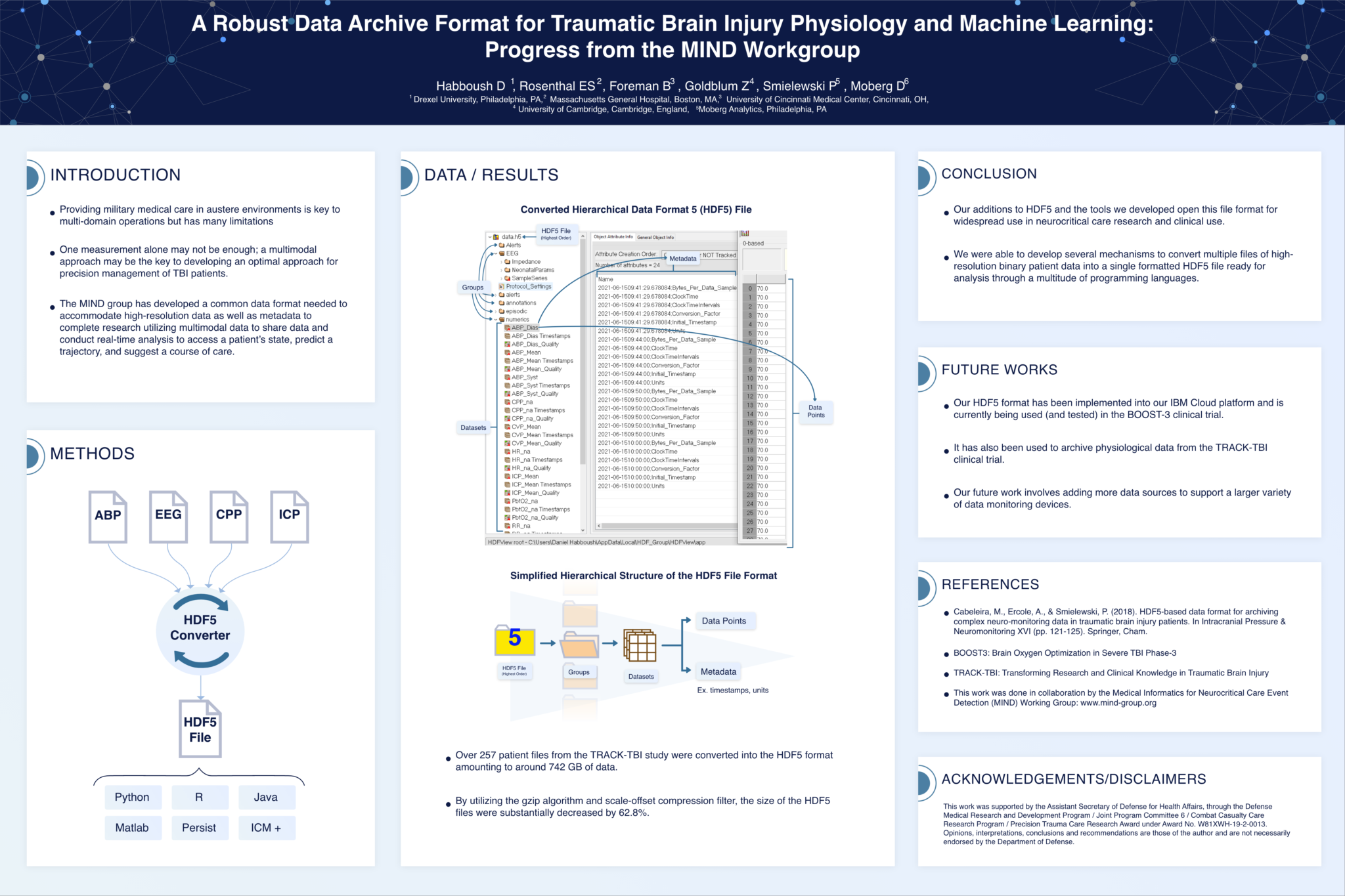RESOURCES
PUBLICATIONS
TRUSTED BY TOP INSTITUTIONS, PHYSICIANS, NURSES, & RESEARCHERS
Your research resource
Moberg Analytics is authoring ground-breaking research and publications with some of the top neurocritical care physicians, nurses, and researchers. They have selected us as their partner and are adopting our analytics platform as their tool of choice.

2023
Neurocritical Care Society (NCS) Annual Meeting
August 2023
Towards the Management of Ground Truth Consensus-Based Knowledge in Neurocritical Care
Towards the Management of Ground Truth Consensus-Based Knowledge in Neurocritical Care
Ethan Jacob Moyer, Xiao Fang, Michael Alec Gomba, Craig Maddux, Dick Moberg.
When information is isolated across literature publications, it can be difficult to see how it all fits together. This is especially true in neurocritical care. Through previous work, our group has extensively reviewed concepts related to harmonization. After exploring many concepts like ontology maps, reference dictionaries, etc., we have determined that a knowledge base is the optimal solution for this problem. This publication serves as preliminary work in an attempt to store, elate, and connect ground truth knowledge in the field that drives the harmonization of concepts, ideas, and data. We aim to extend this work by incorporating this knowledge into CONNECT.
Integration of High-Resolution Multimodal Neuromonitoring Data and Hospital EMR for Automated Near Real-Time Patient Care Reports
Integration of High-Resolution Multimodal Neuromonitoring Data and Hospital EMR for Automated Near Real-Time Patient Care Reports
Craig Maddux, Matthew Kirschen, Alexis Topjian, Ryan Burnett, Ethan Jacob Moyer, Hiep Nguyen, Justin Moore, Zujun Yang, Dick Moberg.
In a close collaboration with the Children’s Hospital of Philadelphia (CHOP), we have successfully been able to deliver neuromonitoring reports for pediatric patients at routine intervals. These reports combine artifact-reduced neurophysiology (ICP, ABP, HR, rSO2, etc.), computer trends (PRx, CPPopt, COx, MAPopt), continuous and non-continuous medication administration, summary metrics, clinical impressions, and a technical summary into a one- to two-page report. The report has been designed with the help of Dr. Matthew Kirschen. Our aim is to continue to deploy and validate this technology across hospitals all over the country.
Methodology of Measuring the Precise Temporal-Spatial Behavior of Electrographic Seizures in Full Term Newborns with Arterio-Ischemic Strokes
Methodology of Measuring the Precise Temporal-Spatial Behavior of Electrographic Seizures in Full Term Newborns with Arterio-Ischemic Strokes
France Fung, Ethan Jacob Moyer, Gabriella Grym, Arastoo Vossough, Courtney J. Wusthoff, Renée A. Shellhaas, Stephanie Rau, Swetapadma Patnaik, Dick Moberg, Robert R. Clancy.
Seizures following arterio-ischemic stroke in neonates are focal in nature but may spread to other areas of the brain, making them ideal to study the dynamics of seizure evolution in terms of duration and location. We developed a novel, reduced EEG montage and tested it against a cohort of 29 neonates to quantify the spatial and temporal behavior of electrographic seizures.
Special Operations Medical Association (SOMA) Assembly
May 2023
Assessing the Clinical Value and Deployability of TBI Monitoring Technology for Prolonged Casualty Care
Assessing the Clinical Value and Deployability of TBI Monitoring Technology for Prolonged Casualty Care
Michael Alec Gomba, Ethan Jacob Moyer, Gabriella Grym, Zack Goldblum, Sean Keenan, Dennis Jarema, Meghan Willner, Victoria Gruen, Kaleigh Kenny, Dick Moberg.
The content of a medic’s pack is incredibly important. If they want to add something in, they likely have to take something out. This is increasingly important in prolonged care scenarios where resources may be limited. Our poster highlights a method we developed in-house for evaluating devices and technology in terms of which are most optimal to use in these environments. Our method crosses the deployability burden of a device – how difficult it is to use in a certain environment – with the value of the measurement(s) it records. By crossing these two scores for over a dozen non-invasive sensors and devices, we were able to rank them in terms of how optimal they are for battlefield use.

2022
Neurocritical Care Society (NCS) Annual Meeting
October 2022
Data Anonymization for Cloud-Based Storage of an Extensible Archive Format in Neurocritical Care
Data Anonymization for Cloud-Based Storage of an Extensible Archive Format in Neurocritical Care
Ethan Jacob Moyer, Quoc Thinh Vo, Edilberto Amorim, Craig Maddux, Dick Moberg.
High-resolution data in neurocritical care is enormous, especially for patients that are monitored for days to weeks at a time. This type of data is ideal for machine learning applications, but certain barriers have traditionally thwarted this type of work. Data acquired from medical devices are often stored in proprietary company formats, making it difficult to use for research. Additionally, this data often contains PHI and cannot be moved outside of the hospital without an intermediate anonymization step. Our work highlights a solution to both of these problems. With the help of Dr. Eddy Amorim at the Zuckerberg San Francisco General Hospital, we successfully deployed software to anonymize and convert data from the Moberg CNS Monitor with the aim to use the hospital’s dataset for research.
A Taxonomy for Defining Derived Metrics in Neurocritical Care for Machine Learning
A Taxonomy for Defining Derived Metrics in Neurocritical Care for Machine Learning
Victoria Gruen, Kayleigh Kenny, Meghan Willner, Craig Maddux, Brandon Foreman, Eric Rosenthal, Daiwai Olson, Dick Moberg, Ethan Jacob Moyer.
Reproducibility is a huge problem across all disciplines of science. As the analyses and algorithms become more complex in neurocritical care, it will be more and more difficult for researchers to standardize their algorithms and effectively communicate them to others. We have a unique opportunity to solve this issue early on before it gets out of hand. This poster highlights preliminary work on a method for standardizing analytics using a pallet of interoperable, modular, and simple functions (standard math operations or reference to a publication describing an algorithm). Each metric produced by this method is computed with a metadata string that describes how the metric was derived.
A Gap Analysis of Common Data Elements for Machine Learning in Neurocritical Care
International NeuroTrauma Society (INTS) Annual Meeting
July 2022
CONNECT: A Platform for High-Resolution Multimodal Data Management for Clinical Trials of Brain Injured Patients
CONNECT: A Platform for High-Resolution Multimodal Data Management for Clinical Trials of Brain Injured Patients
Ethan Jacob Moyer, Craig Maddux, Eric Rosenthal, Brandon Foreman, Jonathan Elmer, Karen Hirsch, Dick Moberg.
Live presentation
Neurocritical Care Journal
June 2022
Harmonization of Physiological Data in Neurocritical Care: Challenges and a Path Forward
Harmonization of Physiological Data in Neurocritical Care: Challenges and a Path Forward
Richard Moberg, Ethan Jacob Moyer, DaiWai Olson, Eric Rosenthal, Brandon Foreman.
Precision Care in Cardiac Arrest ICECAP (PRECICECAP) Study Protocol and Informatics Approach
Precision Care in Cardiac Arrest ICECAP (PRECICECAP) Study Protocol and Informatics Approach
Jonathan Elmer, Zihuai He, Teresa May, Elizabeth Osborn, Richard Moberg, Stephanie Kemp, Jesse Stover, Ethan Jacob Moyer, Romergryko G. Geocadin, Karen G. Hirsch, PRECICECAP Study Team.
Neurocritical Care Performance Measures Derived from Electronic Health Record Data are Feasible and Reveal Site-Specific Variation: A CHoRUS Pilot Project
Neurocritical Care Performance Measures Derived from Electronic Health Record Data are Feasible and Reveal Site-Specific Variation: A CHoRUS Pilot Project
Sophie E. Ack, Shamelia Y. Loiseau, Guneeti Sharma, Joshua N. Goldstein, India A. Lissak, Sarah M. Duffy, Edilberto Amorim, Paul Vespa, Joseph Randall Moorman, Xiao Hu, Gilles Clermont, Soojin Park, Rishikesan Kamaleswaran, Brandon Foreman, Eric S. Rosenthal.
National Neurotrauma Society (NNS) Annual Meeting
June 2022
A Novel Annotation Tool Using Multimodality Neuromonitoring Data Superimposed with Clinically-Relevant Events for Machine Learning
Pediatric Academic Societies (PAS) Annual Meeting
April 2022
Society for Critical Care Medicine (SCCM) Annual Meeting
January 2022
Enhancing the Interoperability and AI Readiness of Neurocritical Care Data
Enhancing the Interoperability and AI Readiness of Neurocritical Care Data
Ethan Jacob Moyer, Steven Lawrence, Isamu Isozaki, Jesse Stover, Daniel Habboush, Craig Maddux, Brandon Foreman, Eric S. Rosenthal, Dick Moberg.

2021
IEEE Signal Processing in Medicine and Biology Symposium
December 2021
Neurocritical Care Society (NCS) Annual Meeting
October 2021
Using Contextual Data to Enhance Machine Learning in Traumatic Brain Injury
Development and Validation of an Open-Source Optimum Cerebral Perfusion Pressure Tool to Guide Precision Care in every Traumatic Brain Injury
Development and Validation of an Open-Source Optimum Cerebral Perfusion Pressure Tool to Guide Precision Care in every Traumatic Brain Injury
Brandon Foreman, Fei L., Eric S. Rosenthal, Craig Maddox, Daniel Habboush, Zack Goldblum, Dick Moberg.
Live presentation
A Robust Data Archive Format for Traumatic Brain Injury Physiology and Machine Learning
The Accuracy of Coma Prediction Improves During the First 3 Days of Neurocritical Care and is Influenced by Severity and Persistence of Neurologic Deterioration: Results from the CHoRUS Workgroup
The Accuracy of Coma Prediction Improves During the First 3 Days of Neurocritical Care and is Influenced by Severity and Persistence of Neurologic Deterioration: Results from the CHoRUS Workgroup
Guneeti Sharma, Nooney S., Sophia Ack, India A. Lissak, Craig Maddux, Dick Moberg, Xiao Hu, Hemphill JC, Izzy S., Eddy Amorim, Brandon Foreman, Eric S. Rosenthal.
Live presentation
Extracting Meaning from Neurocritical Care Annotations Requires a Brain Injury-Specific Natural Language Processing Vocabulary: Progress from the MIND Workgroup
Extracting Meaning from Neurocritical Care Annotations Requires a Brain Injury-Specific Natural Language Processing Vocabulary: Progress from the MIND Workgroup
Guneeti Sharma, DaiWai M. Olson, Sophie Ack, India A. Lissak, Craig Maddux, Edilberto Amorim, J. Randall Moorman, Xiao Hu, Gilles Clermont, Dick Moberg, Brandon Foreman, Eric S. Rosenthal.
Live presentation
Military Health Science Research Symposium (MHSRS)
August 2021
A Cloud-Based Platform for Data Management in Traumatic Brain Injury Clinical Trials (CONNECT): Progress from the MIND Workgroup
A Robust Data Archive Format for Traumatic Brain Injury Physiology and Machine Learning: Progress from the MIND Workgroup
The Severity and Persistence of Neurological Deterioration are Associated with Clinical Outcome: Progress from the MIND Workgroup
The Severity and Persistence of Neurological Deterioration are Associated with Clinical Outcome: Progress from the MIND Workgroup
Guneeti Sharma, Nooney S., Ack S., India A. Lissak, Craig Maddux, Dick Moberg, Xiao Hu, Hemphill JC, Izzy S., Eddy Amorim, Brandon Foreman, Eric S. Rosenthal.
Live presentation
Development and Validation of an Open-Source, Online Optimum Cerebral Perfusion Pressure Tool to Guide Precision Care in Severe Traumatic Brain Injury: Progress for the MIND Workgroup
Development and Validation of an Open-Source, Online Optimum Cerebral Perfusion Pressure Tool to Guide Precision Care in Severe Traumatic Brain Injury: Progress for the MIND Workgroup
Brandon Foreman, Fei Li, Eric S. Rosenthal, Craig Maddox, Daniel Habboush, Zack Goldblum, Dick Moberg.
Live presentation
Using Contextual Data to Enhance Machine Learning in Traumatic Brain Injury: Progress from the MIND Workgroup
International Neuroscience Nursing Research Symposium
August 2021
MIND Collaboraative Effort to Developing Meaning from Annotated Data During Continuous Multimodal Monitoring
MIND Collaborative Effort to Developing Meaning from Annotated Data During Continuous Multimodal Monitoring
DaiWai Olson, Guneeti Sharma, Dick Moberg, Daniel Habboush, Zack Goldblum, Ethan Jacob Moyer, Craig Maddux, Brandon Foreman, Jesse Stover, Eric S. Rosenthal.
Live presentation
